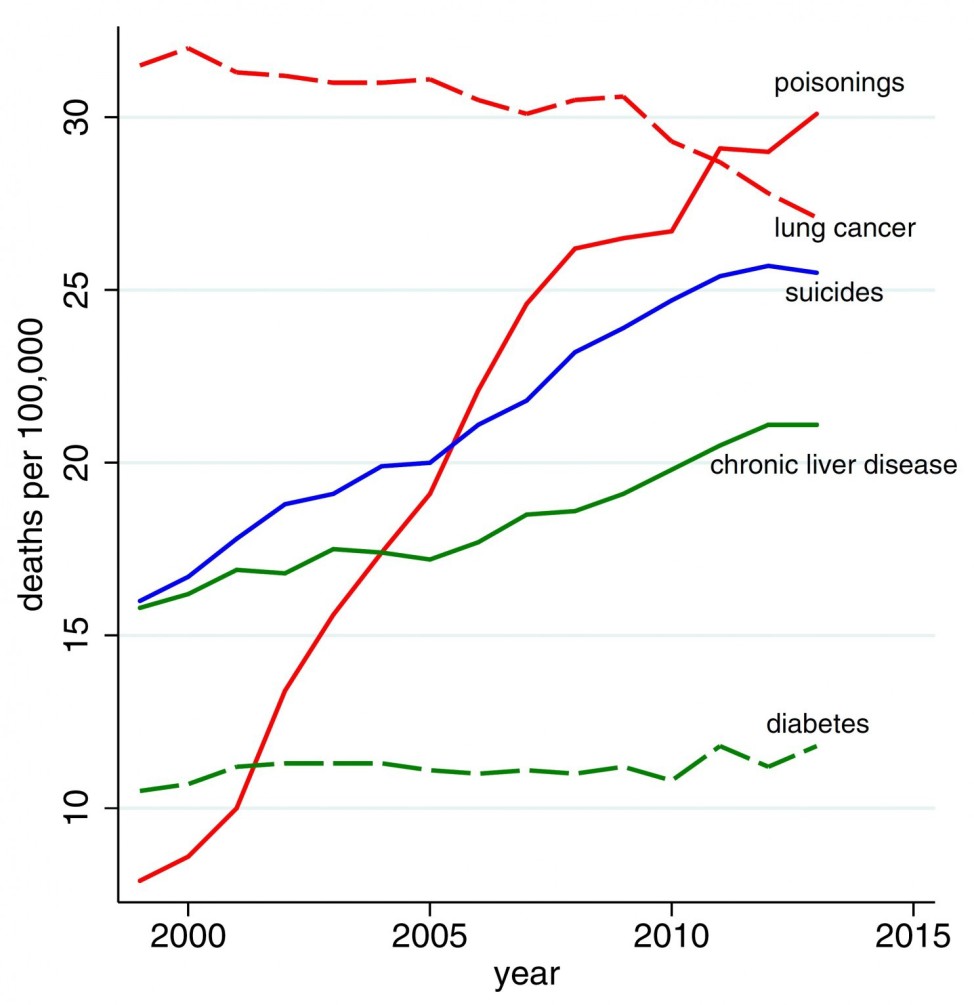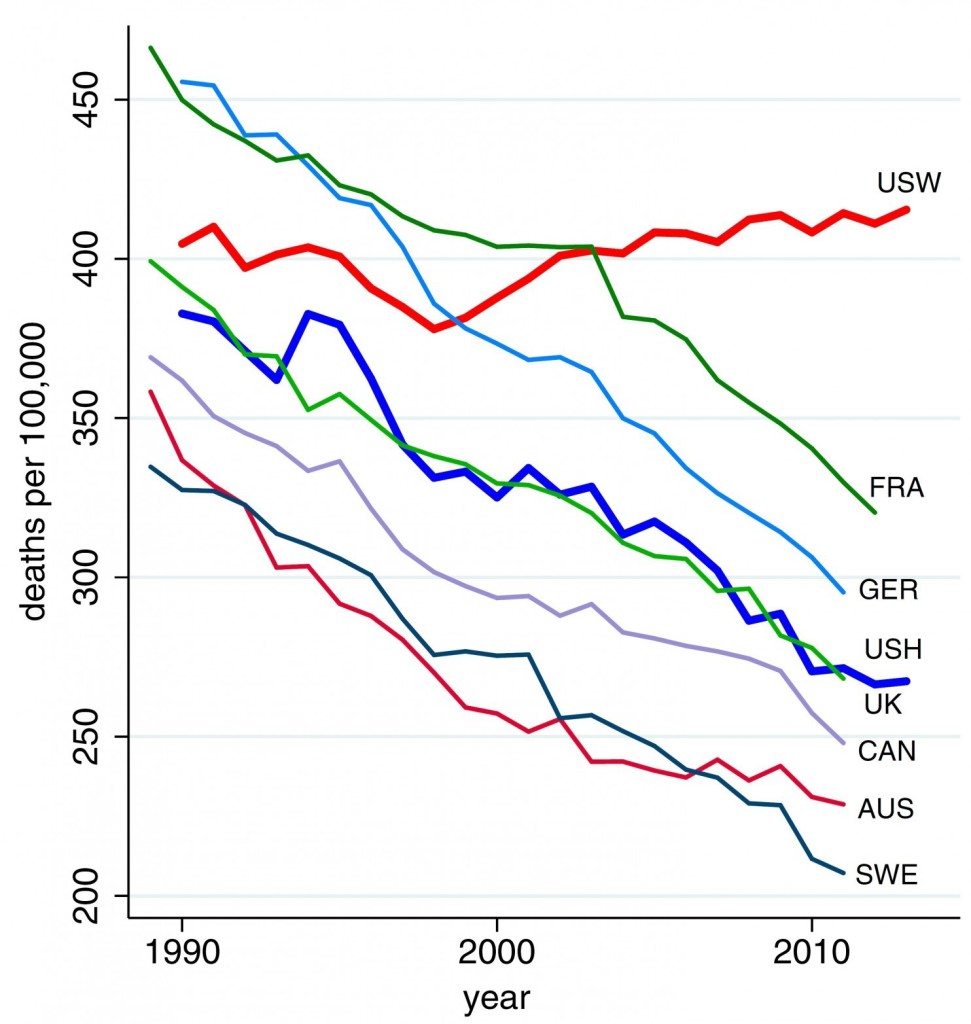
Middle-aged white people without a college degree are dying faster than other Americans, according to researchers from Princeton University. (Photo by Flickr user Andy via Creative Commons license)
Middle-aged white people without a college degree are dying faster than other Americans, according to researchers from Princeton University.
Thanks to medical advances and preventative measures, overall death rates in the United States have fallen in the last century. However, death rates for white people between the ages of 45 and 54 have increased by one-half a percent per year since 1998, said Anne Case and Angus Deaton of Princeton University. Deaton was awarded the 2015 Nobel Peace for economics last month.
Case and Deaton believe drug and alcohol overdoses, as well as suicide, are behind the rise in midlife mortality.

Mortality by cause, white non-Hispanics ages 45–54 (Proceedings of the National Academy of Sciences: “Rising morbidity and mortality in midlife among white non-Hispanic Americans in the 21st century”)
“Midlife increases in suicides and drug poisonings have been previously noted,” the researchers wrote. “However, that these upward trends were persistent and large enough to drive up all-cause midlife mortality has, to our knowledge, been overlooked.”
People in this age group were more likely to report an increase in poor health as well as an increase in pain, including neck pain, facial pain, chronic joint pain, and sciatica.
The study found the hardest hit were those without a college degree. Death rates increased more than 20 percent from 1999 and 2013 for middle-aged people without a college education, while they actually fell for those who did earn a college degree.
Death rates for whites with only a high school diploma are the highest of any race or ethnic group at 736 per 100,000. That could suggest that setbacks at this stage of life — such as job loss or health concerns — could prove particularly difficult for this group of Americans.
“After the productivity slowdown in the early 1970s, and with widening income inequality, many of the baby-boom generation are the first to find, in midlife, that they will not be better off than their parents were,” the researchers wrote.

Death rate for people aged 45–54: US White non-Hispanics (USW), US Hispanics (USH), and six comparison countries: France (FRA), Germany (GER), the United Kingdom (UK), Canada (CAN), Australia (AUS), and Sweden (SWE) (Proceedings of the National Academy of Sciences: “Rising morbidity and mortality in midlife among white non-Hispanic Americans in the 21st century”)
No other rich countries have experienced a similar trend, according to study. Since 1998, mortality rates in developed countries continued to drop by 2 percent each year while US white non-Hispanic mortality rose by half a percent a year.
MORE ABOUT AMERICA
Americans Invent Some Pretty Creepy Stuff
From Ireland to Mexico, Maps Show Changing Face of US Immigrants
The death rate for middle-aged blacks and Hispanics dropped during this same period and so did death rates for younger and older people across all race and ethnic groups.
However, while white death rates — including those with and without a college education — are up, they’re still not as high as black death rates. There are about 415 deaths for every 100,000 white people in the 45-to-54 age group. For blacks, the rate is 581 for every 100,000.
Case and Deaton warn that today’s middle-aged Americans could age into Medicare in worse health than the nation’s current elderly, putting an increased strain on the American health care system.
Comments welcome. Here are VOA’s guidelines.



























Well, maybe a large contributing factor is no insurance or medicine. They make too much to qualify for Medicaid but not enough to buy insurance.
no surprise here… educated people, in general, make better health and lifestyle choice than uneducated people.
*choices*
The title of this article is misleading, suggesting white Americans are dying younger than other groups – when in fact, as the penultimate paragraph states, deaths rates for middle-aged blacks remain significantly higher than for whites!
I noticed the same thing…Someone’s tryin’ to stir up trouble…
So, all is well as long as overall blacks are suffering more.
My points was that the title is arguably inflating the suffering of whites and downplaying the suffering of other groups.
Both of you have raised very good points. There was a time when no insurance company would touch you if couldn’t afford COBRA , and had some health issues, on account of pre-existing condittions. It can happen to an educated person too.
“Middle-Aged White (American) Person” with an Associates Degree here; I had health insurance all of my working life (ages 20 – 48), and have always remained in very good health. In my last position, I earned approximately $110,000 / year. After a major corporate downsizing took place, quality jobs have been scarce. 100’s of resumes have been sent out, and my contacts have been scoured. I’ve ended up being either over-qualified, under-qualified, or ignored. I suspect a fair amount of “age-ism” is also taking place. Ultimately, I’ve settled for jobs paying between $8 and $15 / per hour with no-insurance. During large periods of time, I couldn’t afford a couple of prescriptions I’ve needed. I finally qualified for Medicare. Due in large part to a healthy life-style and luck, I’ve still managed to remain in good health. NOW comes the problem. I recently discovered that I require over $4000 in dental work, at about the same time my car died and required over $2000 in repairs, at about the same time I had to move which cost over $2500, at about the same time that the IRS has come after me for $4300 in penalties for cashing in my 401-K retirement fund which was necessary to pay back child-support to the state, which twice has revoked my drivers license and threatened to put me in jail for non-payment – despite the fact that I’ve been unemployed for large periods of time and my annual income over the past 10 years (worst economic down-turn since the Great Depression in 1929) has dropped to an average of $18,000 / year. Oh yeah, I now have an infection in the tooth area where I require a root-canal, which I can’t afford to have repaired. Good times… goooood times.